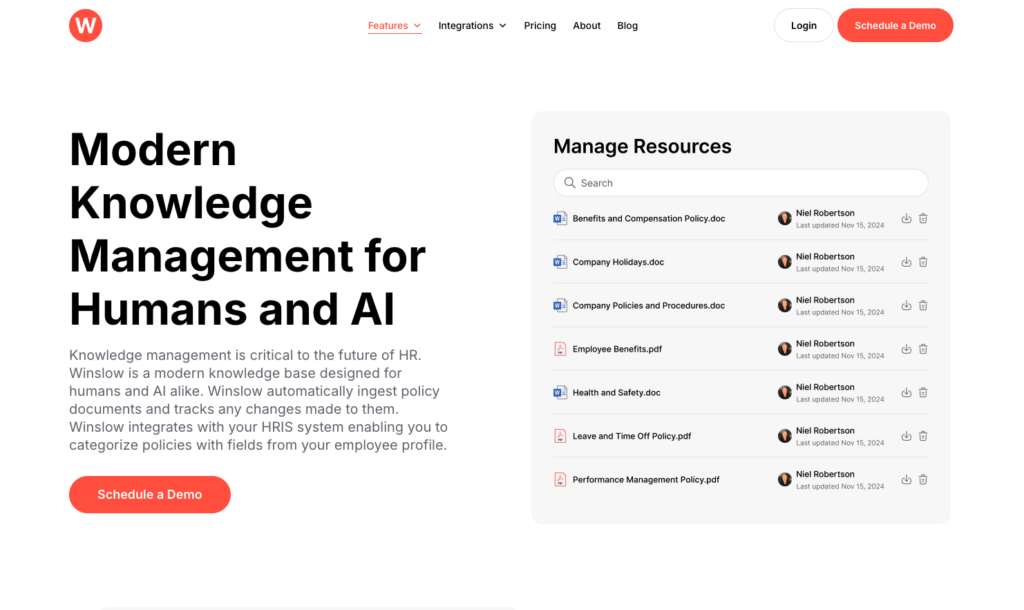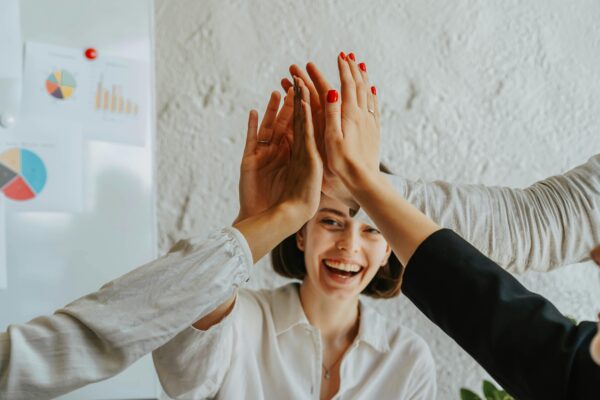In 2025, AI Document Management is reshaping how organizations handle information. AI-tech benefits HR departments, which often deal with large volumes of employee data, documents & policies. Companies are witnessing significant improvements in how they process, store, and retrieve information.
AI Document Management extends beyond simple digitization, offering intelligent features that understand context, extract key data, and even predict future needs based on patterns. For HR professionals, this means less time spent on administrative tasks and more focus on strategic initiatives that drive employee engagement and company growth.
In this post, we’ll explore how AI Document Management is shaping the future of information handling. We’ll also examine some of the top solutions available on the market.
What is AI Document Management?
AI Document Management is the integration of artificial intelligence technologies into traditional document management systems, revolutionizing how organizations handle their information. It automates processes like data extraction, classification, and retrieval & AI enhances efficiency and accuracy, allowing teams like HR to manage large volumes of documents easily.
How Can AI Document Management Systems Help Organizations?
1. Central Knowledge Base
A centralized knowledge base powered by AI enables HR teams to store, manage, and access critical information efficiently. This resource allows employees to find answers to common questions, access policies, and retrieve documents quickly, reducing the time spent on inquiries and enhancing overall productivity.
2. Quick Answers
AI document management systems can create and suggest pre-approved, standardized answers (snippets) for commonly asked questions. Instead of pulling full documents or giving lengthy responses, the system provides concise, relevant answers that have been pre-formatted by the team.
For example, when an employee asks about the vacation policy, rather than showing the entire 20-page HR manual, the system can immediately display the specific snippet about vacation days and approval process.
This feature helps in two ways:
For HR teams: They can create standardized responses for frequent questions, ensuring consistency and accuracy in information sharing
For employees: They get quick, precise answers without having to read through lengthy documents
3. Document Clustering
AI-driven document clustering organizes extensive collections of documents into topic-specific groups, enabling HR teams to quickly identify relationships and retrieve relevant information. This automation enhances efficiency, improves compliance, and supports strategic decision-making by providing insights into employee data and organizational performance.
4. User Empowerment
AI empowers employees by enabling them to manage their information and access documents independently. Employee self-service portals capability reduces the administrative burden on HR teams, enhances employee satisfaction, and fosters a culture of autonomy, allowing staff to find answers and resources quickly without relying on HR for support
5. Document Usage Analytics
AI document management provides valuable insights into how employees interact with company documentation. Through detailed analytics and visualizations, organizations can see the most frequently accessed documents and topics and common search queries that employees use.
For example, if many employees are repeatedly searching for information about healthcare benefits during open enrollment, HR teams can identify this trend and create additional resources or training materials to address these common questions.
Similarly, if certain policies are rarely accessed, they might need to be made more visible or updated to be more relevant. This data-driven approach helps organizations understand what information their employees actually need and use, allowing them to improve their documentation strategy and provide better support.
Related: Employee Experience: What is it and Ways to Improve it?
Top 5 AI Document Management Solutions in 2025
1. Winslow
Winslow is an AI-powered HR solution that streamlines document management for HR departments. It combines artificial intelligence with intuitive design to create a system that manages documents and enhances HR operations.
Key Features:
- AI-powered HR chatbot: Winslow’s chatbot instantly responds to employee queries, reducing HR workload. It can handle many questions, from policy inquiries to benefits explanations.
- Interactive knowledge base: The system maintains an up-to-date repository of HR documents, policies, and procedures. This knowledge base is dynamic, automatically updating as new information is added or existing data is modified.
- 24/7 employee self-service: Employees can access the information they need anytime, improving satisfaction and reducing dependency on HR staff for routine inquiries.
- Workforce analytics: Winslow provides insights into employee engagement and common concerns by analyzing query types and frequency.
- Seamless integration: The platform is compatible with popular communication tools like Slack, Microsoft Teams, and email, ensuring employees can access information through their preferred channels.

- Reduced time spent on repetitive tasks and inquiries
- Improved accuracy and consistency in information dissemination
- Enhancing employee experience through quick, 24/7 access to information
- Valuable insights into workforce needs and concerns
- Streamlined onboarding processes with easy access to relevant documents
2. Google NotebookLM

Google NotebookLM leverages large language models to create an intelligent note-taking and document management experience. This innovative tool combines traditional note-taking simplicity with advanced AI capabilities, making it a powerful solution for managing and analyzing documents.
Key Features:
- AI-powered summaries and key theme extraction: NotebookLM can automatically generate concise summaries of lengthy documents and extract key themes, saving users time and providing quick insights.
- Automatic question generation: The system can create multiple-choice questions, factual/false statements, and discussion prompts based on your documents, making it an excellent tool for learning and comprehension.
- Audio Overviews: This feature provides podcast-like discussions of documents, allowing users to consume information in audio format, enhancing accessibility and convenience.
- Integration with Google Workspace apps: NotebookLM seamlessly integrates with other Google tools like Docs, Sheets, and Slides, creating a cohesive ecosystem for document management and collaboration.
- Customizable AI agents: Users can create and customize AI agents for specific tasks, such as a Learning Coach for educational contexts or a Research Assistant for academic work.
Benefits for Users:
- Enhanced document comprehension through AI-generated summaries and questions
- Improved productivity with automated theme extraction and audio overviews
- Seamless workflow integration within the Google Workspace environment
- Personalized learning and research experiences with customizable AI agents
- Efficient knowledge management and retrieval across multiple document types
3. Guru

Guru is an AI-powered knowledge management platform designed to centralize collective knowledge and make it easily accessible to employees. It focuses on improving knowledge sharing and collaboration within teams.
Key Features:
- AI-powered system-wide suggestions: Guru’s AI proactively suggests relevant information to users based on their current tasks and context, ensuring knowledge is delivered when it’s most needed.
- Browser extension for knowledge capture: An intuitive browser extension allows users to capture and share knowledge from anywhere on the web, making building and maintaining the knowledge base easy.
- Smart organization: Guru uses AI to automatically categorize and tag content, making it easier for users to find the information they need quickly.
- Deep insights and analytics: The platform provides detailed analytics on knowledge usage, helping teams identify gaps and improve knowledge management strategies.
- Customizable knowledge triggers and alerts: Users can set up custom triggers to ensure the right information is shared at the right time and with the right people.
- 200+ professionally designed templates: A wide range of templates helps teams quickly create and standardize various types of documents and knowledge assets.
- Native integration: Guru integrates seamlessly with popular tools like Slack, Microsoft Teams, and other workplace applications, allowing users to access knowledge within their existing workflows.
Benefits for Organizations:
- Improved knowledge sharing and collaboration across teams
- Reduced time spent searching for information
- Increased productivity through contextual knowledge delivery
- Better onboarding experiences for new employees
- Enhanced decision-making with access to up-to-date information
- Streamlined creation and maintenance of knowledge assets
4. M-Files

M-Files takes a unique, metadata-driven approach to document management, enhanced by AI capabilities. This intelligent information management system organizes content based on what it is, rather than where it’s stored.
Key Features:
Intelligent metadata tagging and classification: AI automatically tags and classifies documents, making them easy to find regardless of their location.
AI-powered search and retrieval: Advanced search capabilities allow users to find documents based on content, metadata, or relationships to other documents.
Automated workflows and business process management: M-Files automate document-centric processes, improving efficiency and reducing errors.
Integration with multiple enterprise systems: The platform connects with various business systems, creating a unified view of information across the organization.
Advanced security and compliance features: M-Files offers robust security measures and helps organizations meet regulatory compliance requirements.
Benefits for Organizations:
Improved document findability and reduced search time
Enhanced collaboration through better information sharing
Increased productivity with automated workflows
Better compliance management and reduced risk
Seamless integration with existing business systems
Improved version control and document lifecycle management
5. Box

Box is a comprehensive content management platform that combines robust document management with advanced AI capabilities. It offers a secure, scalable solution for businesses of all sizes.
Key Features:
Box AI for content analysis and insights: AI-powered tools analyze document content, providing valuable insights and improving searchability.
AI-powered content creation tools: Assist users in generating and refining content, enhancing productivity.
Customizable AI agents through Box AI Studio: Allows organizations to create tailored AI solutions for specific business needs.
Seamless integration with productivity apps: Integrates with popular tools like Microsoft Office, Google Workspace, and Slack.
Enterprise-grade security and compliance: Offers advanced security features and helps maintain compliance with various regulations.
Benefits for Organizations:
Enhanced content discovery and insights
Improved collaboration across teams and with external partners
Streamline workflows and increase productivity
Robust security and compliance management
Scalability to meet growing business needs
Customized AI solutions for specific use cases
As we move further into the AI era, tools like Winslow will become indispensable for companies looking to stay competitive and create a more efficient, responsive HR function.





